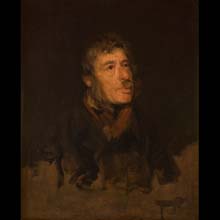
material: oil on canvas
dimensions: 82 x 66 cm
description: Michałowski took a strong interest in portraiture under the influence of paintings by Velázquez, which he saw in Vienna in 1838. Inspired by the works of this distinguished Spanish artist, he portrayed people from his surroundings, often his own children. His sitters also included the common people – peasants, Jews, beggars and old veterans. This resulted in a unique gallery of excellent physiognomic studies, rendered realistically, taking into account the psychological aspect. Old Veteran, a portrait of an old soldier, was painted in three different versions. This work is believed to be a study for a soldier depicted in a monumental equestrian portrait of Napoleon (at the National Museum in Warsaw) dated to 1846. A smaller study, painted in a studio in Bolestraszyce, is from the same period. For his base, the artist used thickly woven canvas, giving vibration to the painting texture. The plastic effect in this painting is also due to the marks of the paintbrush in the form of restless, thick streaks of paint left in the bottom, unfinished part of the bust, as if a record of unconscious, impulsive brushwork in this place. Anna Zeńczak
exposition: The Gallery of 19th Century Polish Art in Sukiennice,
The Cloth Hall, 1, Main Market Square
key: Romanticism. Towards national art >>>
dimensions: 82 x 66 cm
description: Michałowski took a strong interest in portraiture under the influence of paintings by Velázquez, which he saw in Vienna in 1838. Inspired by the works of this distinguished Spanish artist, he portrayed people from his surroundings, often his own children. His sitters also included the common people – peasants, Jews, beggars and old veterans. This resulted in a unique gallery of excellent physiognomic studies, rendered realistically, taking into account the psychological aspect. Old Veteran, a portrait of an old soldier, was painted in three different versions. This work is believed to be a study for a soldier depicted in a monumental equestrian portrait of Napoleon (at the National Museum in Warsaw) dated to 1846. A smaller study, painted in a studio in Bolestraszyce, is from the same period. For his base, the artist used thickly woven canvas, giving vibration to the painting texture. The plastic effect in this painting is also due to the marks of the paintbrush in the form of restless, thick streaks of paint left in the bottom, unfinished part of the bust, as if a record of unconscious, impulsive brushwork in this place. Anna Zeńczak
exposition: The Gallery of 19th Century Polish Art in Sukiennice,
The Cloth Hall, 1, Main Market Square
key: Romanticism. Towards national art >>>












